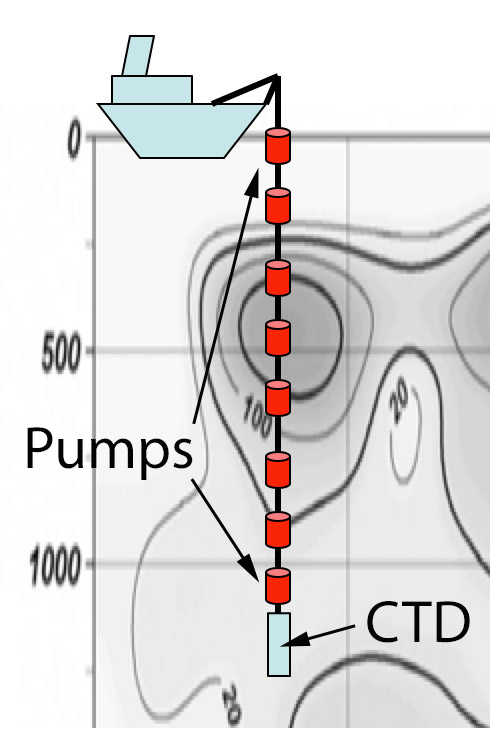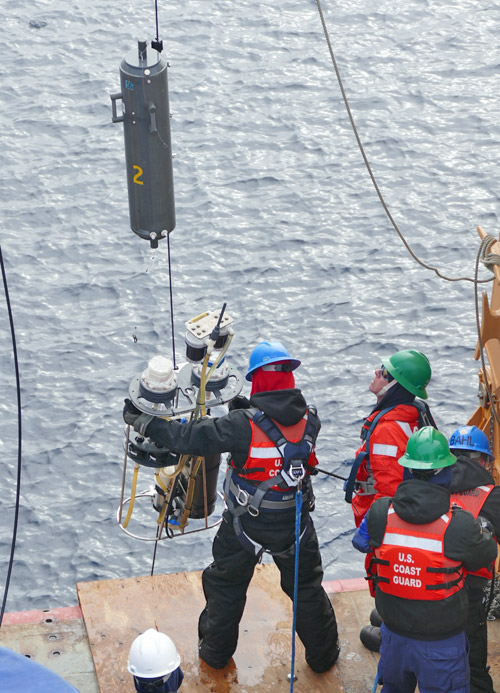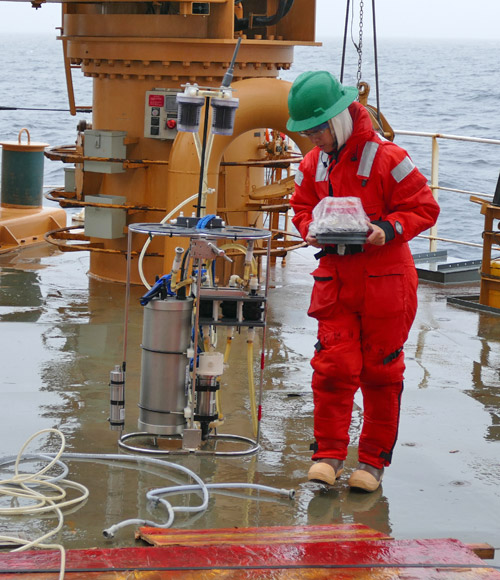Cruise Day 18
Speed 5 knots (kts)
Course 2° (N)
Location Makarov Basin, approx. 435nm NNE of Henrietta Island, Russia
Depth 2390 m
GO DEEPER DISCUSSION: (see previous journal for the questions.)
Hoarfrost crystals such as the ones in yesterday’s photograph tend to grow on surfaces facing into the wind. I’ve seen this happen when cold fog blows onto solid surfaces. The fog is made of microscopic water droplets that are supercooled – that is, they are below their freezing point but lack a starting point, such as other ice crystals falling from higher, colder clouds (seed crystals), or particles such as dust in the air to begin growing on. When the supercooled droplets hit an exposed line or railing, ice crystals begin to grow, and then it is easier for the supercooled droplets to continue growing outward along the existing ice crystals.
TODAY’S JOURNAL:
Our push north continues, and as expected the ice is getting even thicker and more continuous. Progress is still good but a bit slower now, especially as we are still on one engine to conserve fuel. We should reach the next full station sometime tomorrow, aiming for ~83.75°N. We are hoping to include ice sampling operations but so far we haven’t seen suitable ice for scientists to venture out on with drills, pumps, etc. We still have a while to go, though (over a degree of latitude), so optimism persists that we might venture off the ship at the next station.
Last night we had an excellent presentation session with several of the expedition scientists giving short summaries of the work they’ve done so far and initial looks at some of their findings. Questions and discussions after each presentation were illuminating and gave insight into the interconnectedness of data from different groups studying different aspects of the same water.
Phoebe Lam was among the presenters and summarized what had been going on so far with her deep water pump group. I learned quite a bit more about the operation, and thought I’d follow up mention of these pumps in an earlier post (“Pumps”, August 13.) The devices they used are called McClane pumps, and don’t return water to sample but instead pump large volumes of water through filters. The pumps are battery-driven, and operate on a timer since there is no communication between the units and the scientists during their deployment. A pump delivers water to a pair of filters, each designed to catch different sizes of very small particles. In a 4-hour deployment, one filter processes about 1000 liters of water, the other 500 liters. After passing through the filters, the pumped water runs through a pair of canisters that chemically trap radioactive isotopes dissolved in the water. On this cruise, the canisters are mostly used to collect naturally occurring Radium, although other canisters can be used to find anthropogenic (human-made) isotopes from nuclear weapons testing, etc. Since our largest Niskin Bottles bring up 30 liters of water, you can see the importance of the pumping process. Even filling an entire 12 or 36-bottle rosette at one level would bring up only 360 liters of water, but the group deploys McClane pumps at 8 levels during a deep water deployment. 15 different teams are studying samples from the pumping operations, some on board and others waiting for samples back at their home labs.
 Phoebe Lam provided this simple diagram of a McClane pump deployment with eight pumps (red cylinders) placed at target depths along a non-conducting cable. At the end of the cable is a CTD to profile the water column where the water is pumped.
Phoebe Lam provided this simple diagram of a McClane pump deployment with eight pumps (red cylinders) placed at target depths along a non-conducting cable. At the end of the cable is a CTD to profile the water column where the water is pumped.
 Steven “Spike” Pike adjusts a McClane pump unit prior to a deep cast. Note the other pumps around him in the aft staging area.
Steven “Spike” Pike adjusts a McClane pump unit prior to a deep cast. Note the other pumps around him in the aft staging area.
A deep deployment begins with a CTD on the end of a non-metallic cable. The cable used for this operation is similar to the GEOTRACES winch cable but a bit smaller, and it isn’t a conducting cable. This means that there is no communication between the operator and the instruments, so the CTD records data from the cast to be recovered when it is retrieved. With the CTD leading the way, the winch letting out cable is stopped at whatever intervals the group has chosen to sample. These depths are chosen to correlate with the ones sampled by the Go-Flo bottles earlier in the station via the GEOTRACES rosette. The McClane pumps have a clamp to grab the cable, and a Niskin bottle is clamped on above the pump to get a 30-liter water sample at each sampling level. This water is used to analyze Thorium-234 and to compare Radium levels in the unfiltered water to the concentrated amounts in the filtering canister. Since water goes through the canisters quickly, they don’t catch all of the Radium. So 20 liters from the Niskin bottle are filtered through the same kind of filter very slowly to catch all of the radium in the small sample, and by comparing this to the Radium caught in the high-volume canisters, a capture efficiency can be calculated. For example, if it is determined that the canisters are catching 50% of the radium, then the results from that sample would be multiplied by two to come up with the total radium present in the water sampled. The remaining 10 liters are used to study Thorium 234.
 The string of McClane pumps is led down by this CTD unit at the end of the cable.
The string of McClane pumps is led down by this CTD unit at the end of the cable.
 A McClane pump and its accompanying Niskin bottle are recovered from the fantail A-frame crane. Note the small metal cylinder on the cable right above the Niskin bottle – this is the messenger that tripped the bottle.
A McClane pump and its accompanying Niskin bottle are recovered from the fantail A-frame crane. Note the small metal cylinder on the cable right above the Niskin bottle – this is the messenger that tripped the bottle.
Since there isn’t a conducting cable to trip the Niskin bottle, a device called a messenger is used instead. The messenger is a weight that slides down the cable, hitting a release mechanism on the shallowest Niskin Bottle. This sets up a chain reaction where the closing lids on that bottle trigger another messenger drop to the next bottle, closing it and continuing the chain reaction until the last bottle is tripped. When the pumping interval is over, the whole string of bottles, pumps, and CTD are raised back to deck, with the crew pausing at each instrument to remove it from the cable and bring it back into the aft staging area after retrieving the now-loaded filters and full Niskin bottles.
 Phoebe Lam retrieving a filter from a McClane pump deployment.
Phoebe Lam retrieving a filter from a McClane pump deployment.
GO DEEPER!
Why do you think the McClane pump sample depths chosen to match levels sampled earlier on the GEOTRACES rosette cast?
Aloft Con web cam updated every hour
Healy Track
That's all for now. Best- Bill

